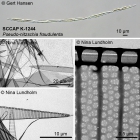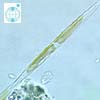Scheldt species taxon details
Pseudo-nitzschia fraudulenta (Cleve) Hasle, 1993
246606 (urn:lsid:marinespecies.org:taxname:246606)
accepted
Species
marine, terrestrial
recent only
(of ) Cleve, P.T. (1896). Report of the phyto-plankton collected on the expedition of H.M.S. 'Research', 1896. <em>In: Fifteenth Annual Report of the Fisheries Board for Scotland, being for the year 1896. Part III. Scientific Investigations.</em> pp. 297-304, 1 pl.
page(s): p. 300; fig. 11 [details]
page(s): p. 300; fig. 11 [details]
Kociolek, J.P.; Blanco, S.; Coste, M.; Ector, L.; Liu, Y.; Karthick, B.; Kulikovskiy, M.; Lundholm, N.; Ludwig, T.; Potapova, M.; Rimet, F.; Sabbe, K.; Sala, S.; Sar, E.; Taylor, J.; Van de Vijver, B.; Wetzel, C.E.; Williams, D.M.; Witkowski, A.; Witkowski, J. (2025). DiatomBase. Pseudo-nitzschia fraudulenta (Cleve) Hasle, 1993. Accessed through: VLIZ Consortium Scheldt Species Register at: https://www.scheldemonitor.nl/speciesregister/aphia.php?p=taxdetails&id=246606 on 2025-09-12
VLIZ Consortium. Scheldt Species Register. Pseudo-nitzschia fraudulenta (Cleve) Hasle, 1993. Accessed at: https://scheldemonitor.be/speciesregister/aphia.php?p=taxdetails&id=246606 on 2025-09-12
Date
action
by
original description
(of ) Cleve, P.T. (1896). Report of the phyto-plankton collected on the expedition of H.M.S. 'Research', 1896. <em>In: Fifteenth Annual Report of the Fisheries Board for Scotland, being for the year 1896. Part III. Scientific Investigations.</em> pp. 297-304, 1 pl.
page(s): p. 300; fig. 11 [details]
context source (Schelde) MWTL biological monitoring network Westerschelde: Phytoplankton [MWTL biologisch monitoring netwerk Westerschelde: Fytoplankton] [details]
additional source Rhodes L., Scholin C., Garthwaite I., Haywood A. & Thomas A. 1997. Domoic acid producing <i>Pseudo-nitzschia</i> species educed by whole cell DNA probe-based and immunochemical assays. In: <i>Harmful Algae</i> (Ed. by B. Reguera, J. Blanco, M.L. Fernández & T. Wyatt), pp. 274-277. Xunta de Galicia and IOC, UNESCO, Santiago de Compostela. [details]
additional source Moestrup, Ø., Akselman, R., Cronberg, G., Elbraechter, M., Fraga, S., Halim, Y., Hansen, G., Hoppenrath, M., Larsen, J., Lundholm, N., Nguyen, L. N., Zingone, A. (Eds) (2009 onwards). IOC-UNESCO Taxonomic Reference List of Harmful Micro Algae., available online at http://www.marinespecies.org/HAB [details]
additional source Lakkis, S. (2011). Le phytoplancton marin du Liban (Méditerranée orientale): biologie, biodiversité, biogéographie. Aracne: Roma. ISBN 978-88-548-4243-4. 293 pp. (look up in IMIS) [details]
additional source Harper, M.A.; Cassie Cooper, V.; Chang, F.H.; Nelson, W.A.; Broady, P.A. (2012). Phylum Ochrophyta: brown and golden-brown algae, diatoms, silicoflagellates, and kin, in: Gordon, D.P. (Ed.) (2012). New Zealand inventory of biodiversity: 3. Kingdoms Bacteria, Protozoa, Chromista, Plantae, Fungi. pp. 114-163. [details]
additional source Tomas, C.R. (Ed.). (1997). Identifying marine phytoplankton. Academic Press: San Diego, CA [etc.] (USA). ISBN 0-12-693018-X. XV, 858 pp., available online at http://www.sciencedirect.com/science/book/9780126930184 [details]
new combination reference Hasle G.R. 1993. Nomenclatural notes on marine planktonic diatoms. The family Bacillariaceae. Nova Hedwigia, Beiheft 106: 315-321 [details]
page(s): p. 300; fig. 11 [details]
context source (Schelde) MWTL biological monitoring network Westerschelde: Phytoplankton [MWTL biologisch monitoring netwerk Westerschelde: Fytoplankton] [details]
additional source Rhodes L., Scholin C., Garthwaite I., Haywood A. & Thomas A. 1997. Domoic acid producing <i>Pseudo-nitzschia</i> species educed by whole cell DNA probe-based and immunochemical assays. In: <i>Harmful Algae</i> (Ed. by B. Reguera, J. Blanco, M.L. Fernández & T. Wyatt), pp. 274-277. Xunta de Galicia and IOC, UNESCO, Santiago de Compostela. [details]
additional source Moestrup, Ø., Akselman, R., Cronberg, G., Elbraechter, M., Fraga, S., Halim, Y., Hansen, G., Hoppenrath, M., Larsen, J., Lundholm, N., Nguyen, L. N., Zingone, A. (Eds) (2009 onwards). IOC-UNESCO Taxonomic Reference List of Harmful Micro Algae., available online at http://www.marinespecies.org/HAB [details]
additional source Lakkis, S. (2011). Le phytoplancton marin du Liban (Méditerranée orientale): biologie, biodiversité, biogéographie. Aracne: Roma. ISBN 978-88-548-4243-4. 293 pp. (look up in IMIS) [details]
additional source Harper, M.A.; Cassie Cooper, V.; Chang, F.H.; Nelson, W.A.; Broady, P.A. (2012). Phylum Ochrophyta: brown and golden-brown algae, diatoms, silicoflagellates, and kin, in: Gordon, D.P. (Ed.) (2012). New Zealand inventory of biodiversity: 3. Kingdoms Bacteria, Protozoa, Chromista, Plantae, Fungi. pp. 114-163. [details]
additional source Tomas, C.R. (Ed.). (1997). Identifying marine phytoplankton. Academic Press: San Diego, CA [etc.] (USA). ISBN 0-12-693018-X. XV, 858 pp., available online at http://www.sciencedirect.com/science/book/9780126930184 [details]
new combination reference Hasle G.R. 1993. Nomenclatural notes on marine planktonic diatoms. The family Bacillariaceae. Nova Hedwigia, Beiheft 106: 315-321 [details]
 Present
Present  Inaccurate
Inaccurate  Introduced: alien
Introduced: alien  Containing type locality
Containing type locality

